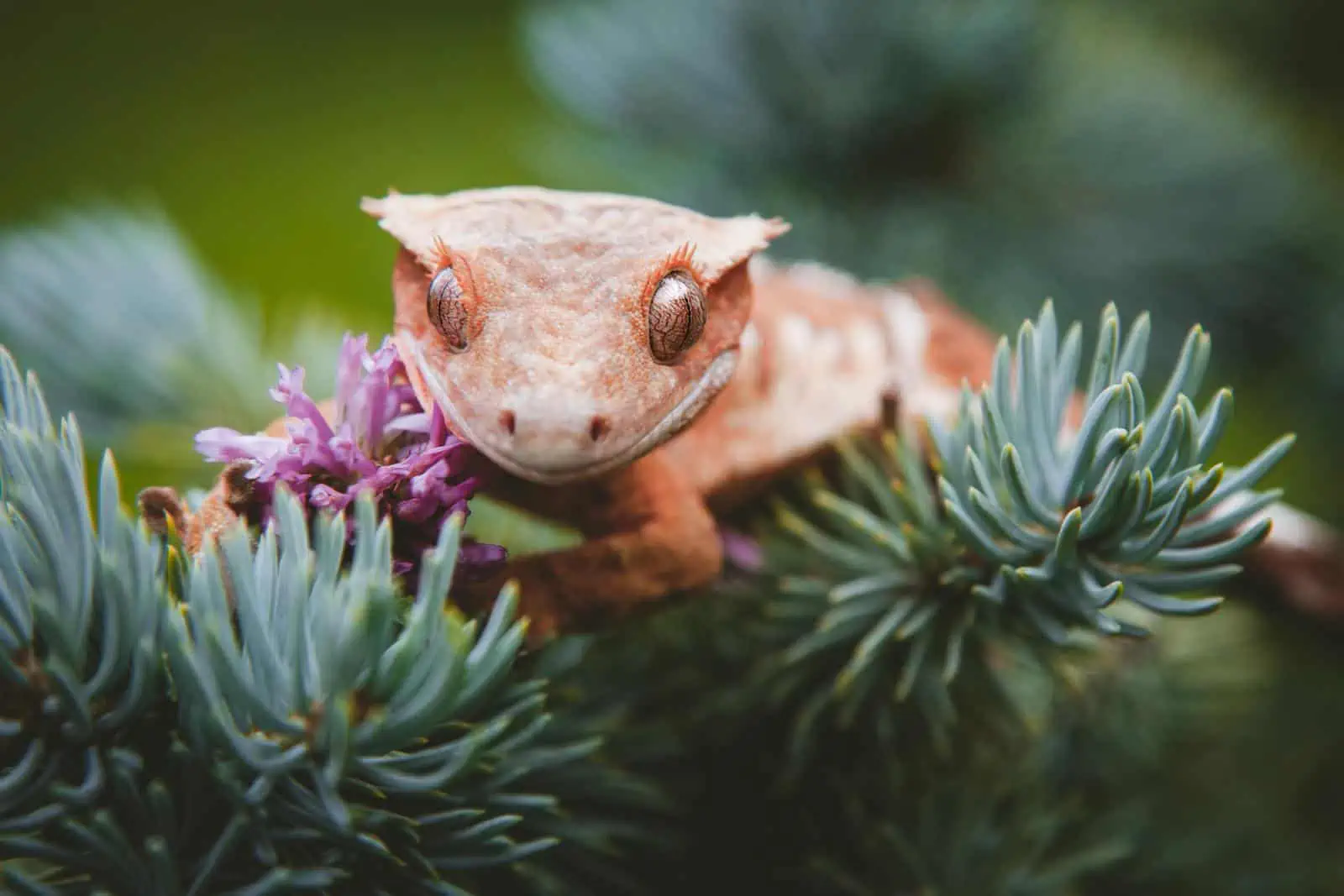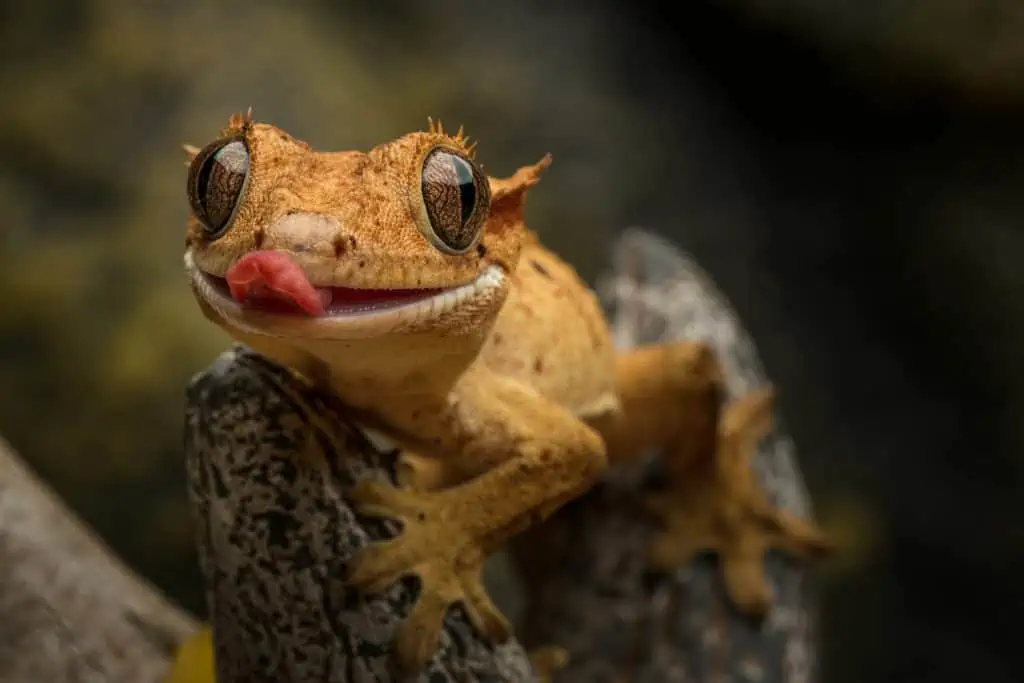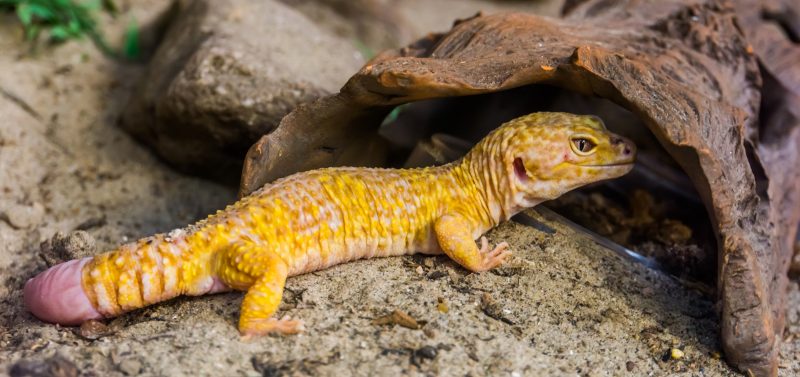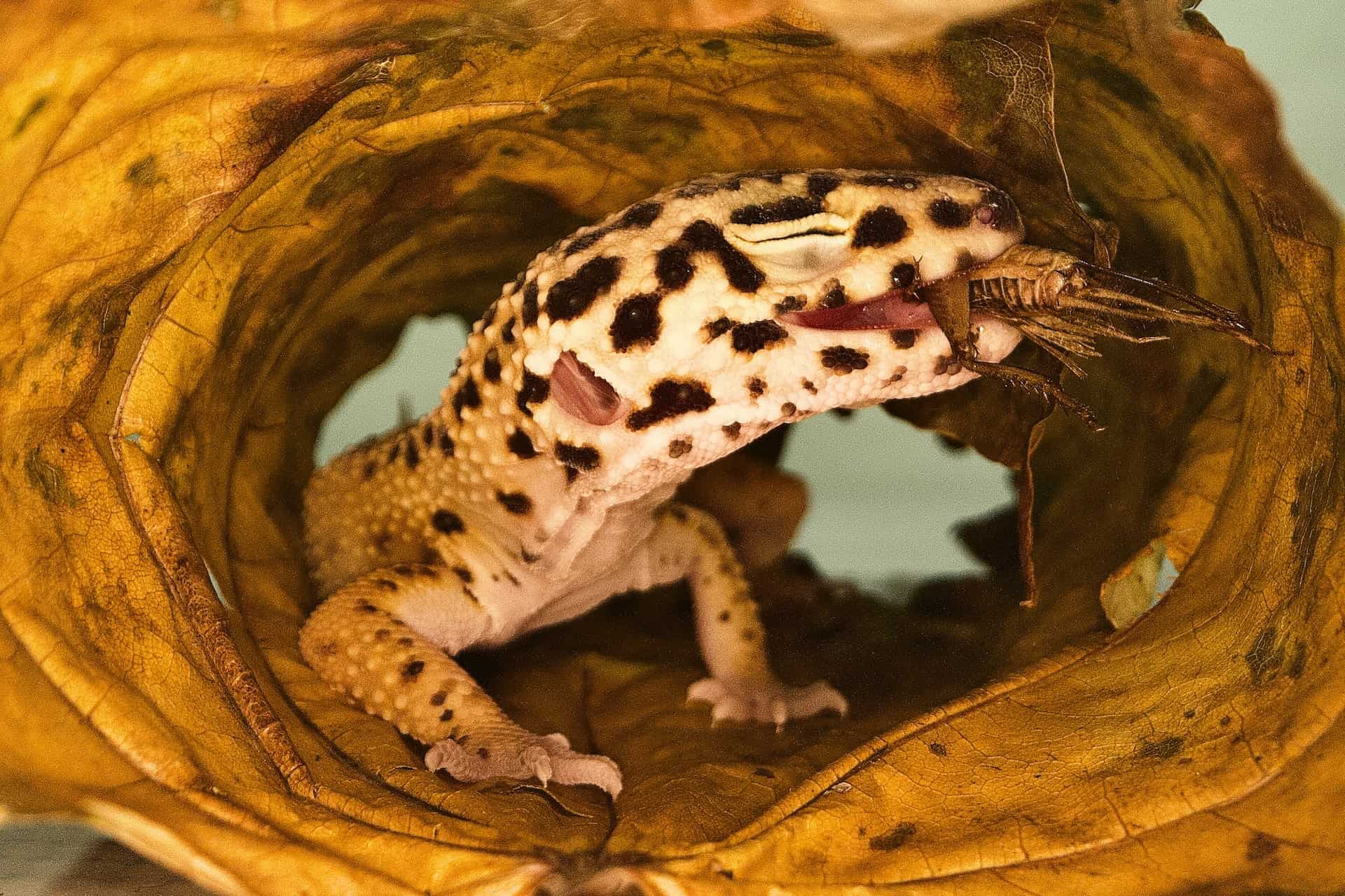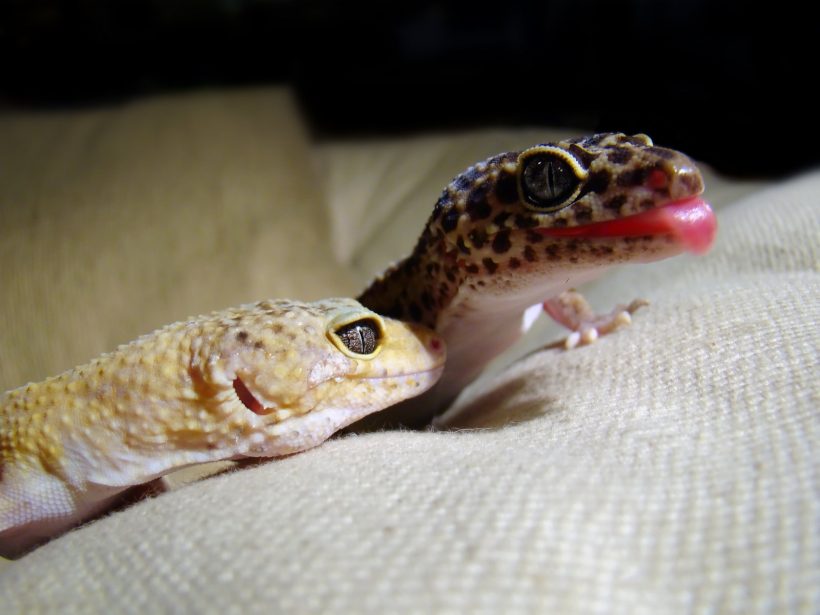Crested and leopard geckos are both beautiful and fascinating creatures in the reptile world, but each has unique characteristics. Choosing the right type of lizard for your household can be overwhelming.
Regarding price, regular morphs of both species can cost you between $40-100$. Some other features are common in both species like:
- Docile temperament
- Same activity level
- Average 8-inch size
- Relatively low maintenance
To compare both species, it’s crucial to consider their space and feeding requirements and their humidity and temperature needs, which vary between them. Both gecko buddies can live up to 15-20 years with proper diet and care.
When deciding between these lizards, consider your lifestyle and what kind of commitment you’re willing to make. Both species can bring joy and companionship.
To help you make a better decision, let’s dive into the details of both geckos.
Crested Gecko Overview
Crested geckos make a unique pet choice because they were once considered extinct but were rediscovered in 1994. Their population has flourished through advanced breeding programs, so much so that they’re a popular option for novice reptile owners and children who want to learn to care for lizards.
You might recognize them by the fringy-crest that runs from their eyes down along their bodies. They’re quite the catch!
Leopard Gecko Overview
Leopard geckos are a type of gecko that lives in the desert, which distinguishes them from other gecko species. They are called “leopard” geckos because of their distinct spotted appearance, with light, pale, almond-colored skin covered in dark spots. You can tell how they’re feeling by the way they wag or shake their fat tails:
- Slow and steady wags mean they’re relaxed.
- Quickly waging or rattling their tails means they’re excited to eat or mate.
- If they’re in danger, they can drop their tail and make a getaway!
Similarities Between Leopard and Crested Geckos
The leopard and crested geckos are on opposite sides of the spectrum, but despite this fact, they share many similarities, which make them perfect pet geckos for those starting.
Size and Weight
Leopard geckos typically measure 8 inches in length on average. However, larger ones can grow up to 10 inches and weigh between 50-70 grams.
Similar to crested geckos; they usually measure 7 to 9 inches and weigh 40-60 grams. Some owners of leopard geckos want their leos to reach the maximum length of 10 inches to be classified as ‘giant’ leopard geckos.
But, without any external manipulation, leos and cresties will remain at the average size of 8 inches.
Activity Level
Leopard geckos are typically crepuscular creatures, meaning they are most active during the late night hours and early morning. Your leo may even have the same routine every night. They might stay in a certain area of the enclosure as if they know what’s coming when daylight hits.
But, regarding crested geckos, things may get a bit tricky. While they tend to be crepuscular, some research suggests they may be nocturnal. They’ll start searching for food and exploring their environment as soon as the sun sets and will hide away when it’s time for the day to begin. However, most crested geckos remain crepuscular, so don’t be surprised if your little friend follows this pattern.
Behavior
Crested and leopard geckos can make great pets but require different interaction levels.
Cresties, for instance, are typically docile but can be jumpy around humans, so if you’re looking to have one as a pet, it’s best to take time to get it used to you.
On the other hand, leopard gecko’s behavior is super chill, they make noises like chirps, barks, and squeaks, so if you’re looking for a lizard who’s not scared of your presence, this is the gecko for you! Both geckos can make great companions with regular handling and training.
Cost
If you’re looking at getting a leopard or crested gecko, you should know that both tend to cost around the same.
Usually, a regular morph of either species can be found for $40-$100 from a reputable breeder.
But here’s the kicker: some morphs can be super rare, and that can drive up the price. I’m talking about the rarest kinds of morphs.
- Take, for example, the Black Night leopard gecko. It’s considered one of the rarest, and some folks are willing to pay up to a whopping $3000 to get one.
- And it’s not just leopard geckos; crested geckos have their sought-after morphs too. One of the most coveted ones is the cream-on-cream morph. Now, these beauties can also cost you a pretty penny, easily reaching $1,000 and beyond.
Similarities at a Glance
| Feature | Crested Gecko | Leopard Gecko |
| Size and Weight |
|
|
| Activity | Crepuscular or nocturnal | Crepuscular |
| Behavior | Docile temperament, skittish and jumpy behavior, but it can still be handled with caution and proper training. | Less prone to biting, vocal, and can be easily trained to be handled. |
| Cost |
|
Almost the same as for cresties |
Differences Between Crested Geckos and Leopard Geckos
Besides similarities, there are a lot of differences between the crested and the leopard gecko. Let’s look at some of the major ones between the two species.
Appearance
Cresties are unique creatures. Their natural colorings range from brown to green and even red. But, through selective breeding, you can also find them in many more colors. Plus, they get their name from the ridges that run down both sides of their heads. It’s diamond-shaped and softer than you’d expect, like suede.
On the other hand, leopard geckos usually feature yellow coloring with irregular black spots and a white tummy. But again, they come in many colors and patterns, from orange to lavender to black and brown. They have a triangular head, long body, slim digits, and segmented tail.
Health and Care
Caring for crested geckos requires the right setup and some maintenance. To stay comfy, you must ensure your furry friend has a heat lamp, timer, and misters. A simple red light bulb will do the trick if you live somewhere warm! Humidity levels can be harder to regulate, but you’ll need to ensure your gecko is in the perfect environment to live a happy life of 10-15 years.
For leopard geckos, you won’t have to worry about humidity levels as much. They don’t require as much, and an incandescent light bulb will provide enough warmth. You’ll be rewarded with 8-20 years of love and companionship with the right care!
Enclosure Requirement
Both geckos need at least a 10-gallon enclosure to have enough space for everything. However, it’s important to note that 10-gallon tanks are the minimum size recommended. But I suggest going for a 20-gallon tank, if possible.
Regarding the crested gecko’s enclosure, you must ensure it’s more vertical. After all, they are semi-arboreal and need lots of space for climbing and roaming above the ground.
Unfortunately, vertical enclosures are more expensive than your standard ones, so it’s worth considering.
On the flip side, leopard geckos don’t require a vertical enclosure since they’re ground dwellers. As long as they have a hide and other enrichment items in their habitat, they’ll thrive.
Humidity and Temperature Needs
Humidity and temperature are key for both the leopard and crested gecko. You must ensure their enclosure is well-regulated to meet their needs.
Leopard geckos require less humidity than crested geckos and prioritize high temperatures on the warm side of their enclosure. Your leopard gecko needs:
- Temperature range: 75° to 90°F
- Humidity range: 30%-40%
On the other hand, your crested gecko will need a slightly lower temperature range as well as higher humidity levels. To ensure your crestie stays healthy, give them the following:
- Temperature range: 70°F-85°F
- Humidity range: 60%-80%
A light, frequent misting of the dry areas in their enclosure will ensure these levels stay where they need to be.
Feeding
Feeding your leopard gecko can be tricky; they have definite preferences regarding their food. You must gut-load and dust their insects 48 hours before feeding, providing them with vital nutrients like Vitamin D.
On the other hand, crested geckos are a breeze to feed. Pick up a commercial crested gecko food and occasionally treat them with fruits or live insects that have been gut-loaded and dusted with calcium and vitamin powder.
Breeding
Regarding breeding, crested and leopard geckos have a few significant differences.
- Breeding crested geckos is a cinch, especially for novice reptile keepers! All you need is to place a mature male and female within the same enclosure. It’s almost guaranteed they’ll copulate in no time. January usually marks the beginning of their mating season, which lasts until September or October. You can expect the female to lay anywhere from 1-10 clutches of two eggs every 2-6 weeks, with hatching occurring after around two months.
- Leopard geckos mate throughout the year when in captivity, but in their natural habitat, their breeding season begins around January and ends around September or October. It’s best to house more than one female with the male to prevent him from bullying her. You can expect the gestation period to be between 16-22 days after copulation and for her to lay a clutch of eggs every two to three weeks over four or five months. After around two months, baby geckos will have hatched from their eggs.
Differences at a Glance
| Feature | Crested Gecko | Leopard Gecko |
| Appearance | Varied color morphs and ridges on either side of the diamond-shaped head. | The animal has a triangular head, long body, slim digits, and a yellow color with black spots. |
| Health and Care | Require low heat and high humidity to stay healthy. | Require low humidity and high heat to be healthy. |
| Life-Span | 10-15 years | 8-20 years |
| Enclosure Requirement | Require more vertical 10 or 20-gallon tanks. It’s more expensive. | Require a simple tank of 10-20 gallon size. |
| Humidity Need | 60%-80% (require a more humid environment) | 30%-40% (require less humid tank setup) |
| Temperature Need | 70°F-85°F | 75° to 90°F |
| Feeding | Can thrive on both commercial diet and live insect diet. | Requires a diet of live insects or worms along with vitamin supplements. |
| Breeding | Breeding time: January to September or October.
Number of eggs: 1-10 clutches of 2 eggs Gestation period: 2-6 weeks Hatching of eggs: after 2 months |
Breeding time: Throughout the year in captivity.
Number of eggs: 6-8 clutches of 2 eggs Gestation period: 16-22 days Hatching of eggs: after 2 months |
What Physiological Differences Distinguish Leopard and Crested Geckos?
In addition to their physical characteristics and morphs, a few physiological factors differ greatly between leo and crested geckos. Let’s talk about them.
Eyelids and Eyelashes
Crested geckos don’t have eyelids, which is typical of their species. But they have a transparent layer of scale across their eyes that protects them while they sleep. They use their tongues to wipe away dirt and dust to keep everything clean. Plus, they have pretty eyelashes, which are absent in other geckos.
Leopard geckos, on the other side, have eyelids and no fancy lashes! They can blink and usually keep their eyes shut when they snooze.
Tail Shape
The cresties have a thin tail that is narrower than its body, while the Leopard Gecko has a fat tail that tapers towards the end.
Due to the fat tail, the leos appear to have a similar width from head to toe.
Toe-Pads for Climbing
Crested geckos have special toe pads that allow them to stick firmly on any surface, regardless of their steepness or incline. These toes are the perfect tool for a semi-arboreal lifestyle!
While leopard geckos lack toe pads because they don’t need them for any particular purpose, all they need to do is use their toes to catch prey, get too-warm spots, or walk on your hand, and that’s it!
Regeneration of Tail
Leopard geckos can self-amputate their tails in a fight or flight situation. But no need to worry; their tails can grow back.
Unfortunately, crested geckos don’t get the same luxury. When their tail falls off, they’re tail-less for life. But don’t worry if you’ve got one- cresties can still thrive without their tails. However, they may have a harder time hunting for food and climbing.
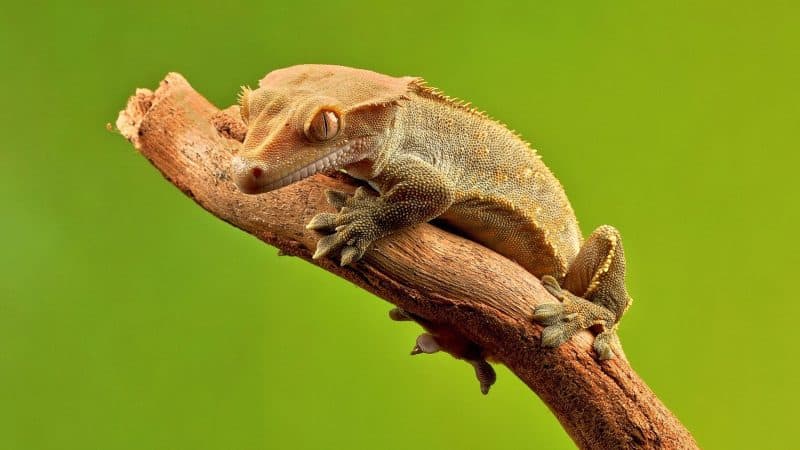
Physiological Differences at a Glance
| Physiological Trait | Crested Gecko | Leopard Gecko |
| Eyelids and Eyelashes | Have eyelashes but not eyelids. | Have eyelids but not eyelashes. |
| Tail-Shape | Have a thin, narrow tail | Have fat tail with tapering ends |
| Toe-Pads | Have toe-pads for climbing | Lack toe-pads |
| Regeneration of Tail | They can’t regenerate their tail. | Can regenerate their tail |
Crested Gecko vs. Leopard Gecko: Pros and Cons
Now, you have a glimpse of both similarities and differences between both geckos, but before deciding which one is the best fit for you, it is important to compare their pros and cons.
Pros and Cons of Leopard Gecko
| Pros | Cons |
|
|
Pros and Cons of Crested Gecko
| Pros | Cons |
|
|
So Which Is Best for You?
If you’re a new reptile owner interested in learning about lizard and reptile care, the crested gecko is a great option. Sure, they are low maintenance, but there’s still a learning curve when calibrating their enclosure’s temperature and humidity. Thus, if you’re not prepared to put in the effort or have young children who cannot care for them, this might not be your best choice.
And if you’re looking for a pet to observe and not handle, then the leopard gecko is perfect. They’re hardy and require minimal attention when it comes to heating and other maintenance. But if you’re not keen on feeding live insects, this lizard might not be for you. Understanding proper heating and feeding protocols is key to the proper care of leopard geckos, and younger kids may not comprehend it fully.
Take Care!
It boils down to what you want from a pet. The Crested and the Leopard Gecko are great companions if you want something low-maintenance. They both have different pros and cons, so it’s a matter of personal preference. No matter which one you choose, you can be sure that both of these species have the potential to bring a lot of joy and entertainment.
Have you already chosen between the Crested and the Leopard Gecko?, Which one did you go with and why? We’d love to hear your story in the comments!

